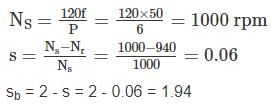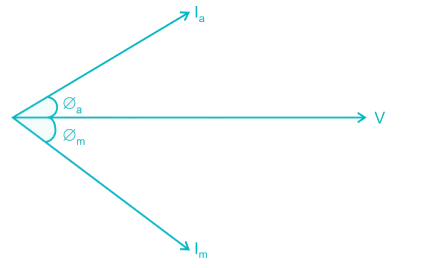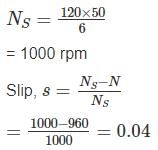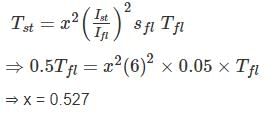Test: Electrical Machines- 6 - Electrical Engineering (EE) MCQ
10 Questions MCQ Test - Test: Electrical Machines- 6
A 2 pole, 50 Hz single phase induction motor running at 2600 rpm has an effective rotor resistance and reactance each of 0.5 Ω. The stator impedance and magnetizing current are to be neglected. The frequencies of rotor current in forward branch and in backward branch are to be respectively
A 250 V, 700 W, 50 Hz, 6 pole single phase induction motor is rotating is clockwise direction with a speed of 960 rpm. The rotor resistance at standstill is 10 Ω. What is the effective rotor resistance is the backward branch of the equivalent circuit in ohms?
| 1 Crore+ students have signed up on EduRev. Have you? Download the App |
The direction of rotation of a single-phase capacitor run induction motor is reversed by
A 50 Hz, 6 pole, single phase induction motor is rotating in the clockwise direction at a speed of 940 rpm. The slip of motor in the direction of rotation and opposite direction of motor will be respectively.
The starting current and torque of a three phase induction motor on direct line starting is 45 A and 600 Nm respectively. What are the corresponding values with star delta starter.
The value of the starting capacitor required to produce 90° phase difference between the currents in the main and auxiliary windings will be – (in μF)
An 8 pole 40 kW, 125 V, 50 Hz single phase motor is running at speed at 720 rpm with forward field torque of 200 N-m end backward field torque of 40 N-m. If friction and winding losses are 20 w, what is the mechanical power output in watts?
A 6 pole, 350 W, 110 V, 50 Hz single phase motor is running at 960 rpm with forward field torque of 220 N-m and backward field torque of 30 N-m. If friction and winding losses are 10 W, What is the mechanical power output?
Determine the current drawn from the main as a fraction of full load current of an auto transformer starter for an induction motor required to start the motor with 50 percent of full-load torque. The short circuit current of the motor is 6 times the full load current and full load slip is 0.05.
A induction motor is started in first case by autotransformer with 3/4th tapping and is second case by a star delta starter. What is the ratio of supply current at starting of first case to second one upto two decimal places





































